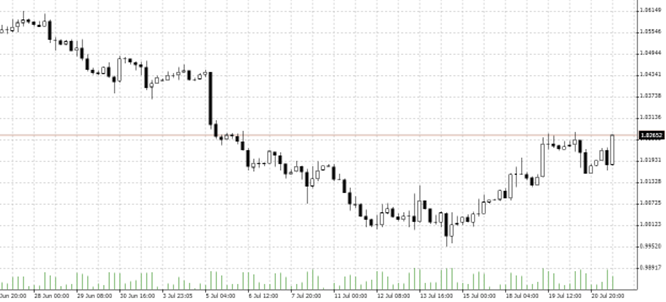

21.07.2022 – The European Central Bank (ECB) has raised interest rates for the first time in eleven years. Contrary to expectations, it did so quite sharply, by 0.5 percent. However, this is not – yet – a real turnaround for the euro: The increase is too weak to stop inflation. And it is a dangerous signal for the highly indebted euro countries and for the economy.
Most analysts had expected only plus 0.25 percent – ergo, they were caught on the wrong foot. Especially since the negative interest rate of minus 0.50 percent for parked money from commercial banks has also been dropped. Moreover, the ECB has already held out the prospect of another interest rate step for its meeting on September 8. And so EURUSD managed a small jump, as you can see in the four-hour chart.

Source: Bernstein Bank GmbH
Many economists suspect that the interest rate will rise to 1.5 percent next spring. How this hesitant pace will contain inflation is a mystery. After all, inflation is currently at 8.6 percent in the euro zone, with 7.6 percent forecast for the year as a whole. That would be an all-time high. Whether the interest rate turnaround will help the euro in the medium term is anyone’s guess.
Determined Fed
Ultimately, the ECB is lagging behind: as the International Monetary Fund has determined, 75 central banks around the world have already raised their key interest rates since July 2021. Above all, its major counterpart in the U.S. is benefiting from the Federal Reserve’s comparatively spirited intervention: since the spring, the Fed has raised its key interest rate to between 1.5 and 1.75 percent. The rate hike in June alone amounted to 0.75 percent – the biggest since 1974. There is likely to be more to come. Ergo, investors have invested vast sums in the U.S., where the yield is higher. Moreover, since energy is paid for in dollars, this supports the greenback and further fuels inflation in Euroland.
Acute risk of recession
Even the current interest rate hike is poison for the economy and “actually comes at an inopportune time,” M.M.Warburg commented in advance. Because the energy crisis could throw the euro zone into a severe recession. Companies don’t need more expensive loans and home builders don’t need higher mortgage rates. The problem for the ECB is the debt situation in the crisis countries – first and foremost Italy, where, in addition, the government has to resign once again. Drastically higher interest rates could severely shake up the national budgets on the southern fringes.
The upshot of all this is that the euro has not received any real boost. The question of all questions has not been answered: How does the ECB plan to stop inflation while ensuring that debt countries can continue to borrow money at low interest rates? Whether the new anti-crisis program, the so-called Transmission Protection Instrument (TPI), will be effective remains to be seen. To this end, the monetary guardians will buy bonds from crisis countries, which will ultimately increase the money supply and weaken the euro. But perhaps the crisis countries will manage the miracle and build up a robust economy. Whether long or short – Bernstein Bank wishes successful trades and investments!
Important Notes on This Publication:
The content of this publication is for general information purposes only. In this context, it is neither an individual investment recommendation or advice nor an offer to purchase or sell securities or other financial products. The content in question and all the information contained therein do not in any way replace individual investor- or investment-oriented advice. No reliable forecast or indication for the future is possible with respect to any presentation or information on the present or past performance of the relevant underlying assets. All information and data presented in this publication are based on reliable sources. However, Bernstein Bank does not guarantee that the information and data contained in this publication is up-to-date, correct and complete. Securities traded on the financial markets are subject to price fluctuations. A contract for difference (CFD) is also a financial instrument with leverage effect. Against this backdrop, CFD trading involves a high risk up to the point of total loss and may not be suitable for all investors. Therefore, make sure that you have fully understood all the correlating risks. If necessary, ask for independent advice. CFDs are complex instruments and are associated with the high risk of losing money quickly because of the leverage effect. 68% of retail investor accounts lose money trading CFD with this provider. You should consider whether you understand how CFD work and whether you can afford to take the high risk of losing your money.7
